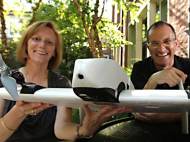SUAVe could enable more efficient archaeological mapping
 Aside being used by military and in search and rescue missions, UAVs can be used to gather data from archaeological sites. Currently used methods in archaeological mapping usually require years to map the sites, but a Semi-autonomous Unmanned Aerial Vehicle (SUAVe) developed by a group of researchers from Vanderbilt University can be used to complete this tedious task in minutes.
Aside being used by military and in search and rescue missions, UAVs can be used to gather data from archaeological sites. Currently used methods in archaeological mapping usually require years to map the sites, but a Semi-autonomous Unmanned Aerial Vehicle (SUAVe) developed by a group of researchers from Vanderbilt University can be used to complete this tedious task in minutes.
The project is an interdisciplinary collaboration between Vanderbilt archaeologist Steven Wernke and engineering professor Julie A. Adams, who combined the Skate by Aurora Flight Sciences unmanned aerial vehicle with sensory system and algorithms that can discern an optimal flight pattern and transform the resulting data into 3D maps.
“It can take two or three years to map one site in two dimensions”, said Wernke. “The SUAVe (pronounced SWAH-vey) system should transform how we map large sites that take several seasons to document using traditional methods. It will provide much higher resolution imagery than even the best satellite imagery, and it will produce a detailed three-dimensional model.”
The algorithms developed for the project allow the SUAVe system to specify the flight pattern to compensate for factors such as the wind speed, the angle of the sun and photographic details like image overlap and image resolution. When it completes capturing the images, it lands and the gathered data is merged and transformed into a map. The system is developed to be easy to operate without on-site technical help.
“Archaeology is a spatial discipline. We depend on accurate documentation of not just what artifacts were used in a given time period, but how they were used in their cultural context. In this sense, SUAVe can provide a fundamental toolset of wide significance in archaeological research”, said Wernke. “The SUAVe system should be a way to create a digital archival registry of archaeological sites before it’s too late. It will likely create the far more positive problem of having so much data that it will take some time go through it all properly.”
Vanderbilt researchers scheduled tests of the system from mid-July to mid-August at the abandoned colonial era town of Mawchu Llacta in Peru, and plan to return next year after any issues that arise are addressed in the lab. Fitted with different set of sensors, SUAVe could also be used to track the changes in environment and climate, or as first responders at disaster sites.









Wasn’t there a research by people from EPFL who used UAVs to record 3D data of a village?
Is there any video of that UAV actually flying since its design is strange?
author
I even read the research paper those researchers from EPFL published after a friend who’s on his PhD there suggested it, but never took the time to write about it… Will have to write some “better late than never” article about that research since it is interesting.
There’s a video and more information about the Skate UAV by Aurora Flight Sciences on its own page at their website.